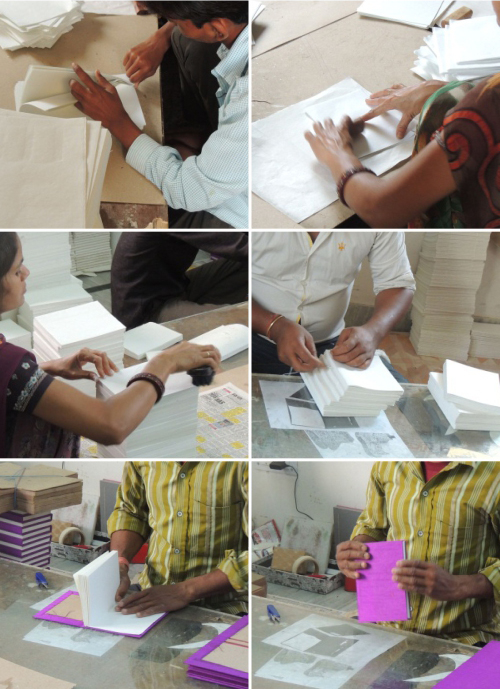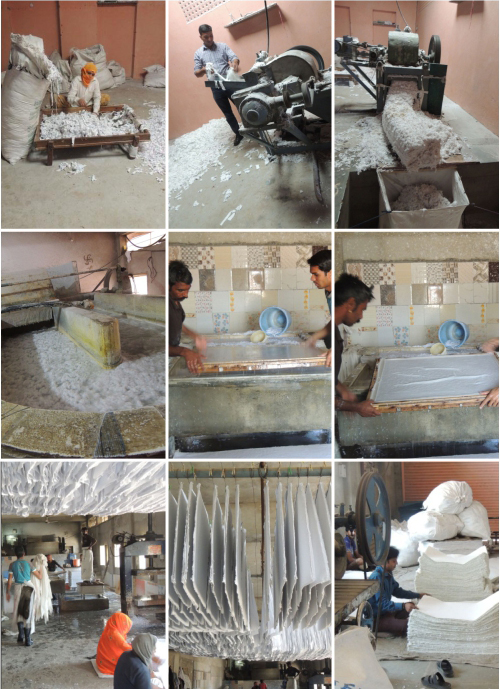History of Handmade Paper
The Handmade Paper Industry is an ancient craft of India.
Handmade Paper sector uses non-wood raw materials such as cotton rags, hosiery cuttings, jutewaste, waste paper, grasses and agro-waste such as wheat, rice straw, and banana fibres etc.
Paper Mills use Bamboo, Eucalyptus and other forest based wood fibres as raw materials. Statistics reveal that for manufacture of one ton of Paperboard paper mills require 2.5 to 3 tons of Dry forest based materials. Thus handmade paper industry help to preserve forests.
Not only this, in Paper Mills the effluents are highly toxic and contain large quantities of chemicals for treatment of Raw Materials. For Handmade Paper Units, there is negligible chemical treatment.
Characteristics
Handmade paper has the following unique characteristics
- Handmade paper has the advantage of being 100% wood free which makes it the most eco friendly form of paper.
- Has elegant and exquisite surface for writing and drawing and printing.
- It has great tensile, bursting, tearing and double fold strength compared to conventional paper.
- It has unmatched texture for drawing by artists and engineers.
- It does not become brittle by ageing.
Manufacturing Process Flow chart
The basic steps/operations involved in the handmade paper making process are given below:
- Sorting and Dusting: The raw material, waste cotton rags procured as waste from readymade garments are sorted by hand to remove foreign materials that would contaminate the pulp.
- Rag Chopping: The sorted cotton rags are put through a mechanized rag chopper that cuts the rags into small uniform sized pieces for making the pulp.
- The Beating: The chopped rags are beaten to pulp in a power operated Hollander beater. During the beating process, these cotton rags are converted into stock i.e. semi-finished pulp, in the initial stage. The material is washed off by means of a washer drum. Natural fillers, loadings, dyeing and internal sizing chemicals like rosin soap and alum are added to give the paper the desired physical properties and consistency required. The beating process is continued till the semi-finished pulp is converted into fine pulp. While making colored or textured papers, the color dyes and or textured materials like straw, hemp, grass, silk or jute fibres etc are added during this process. The resulting pulp is now ready for sheet formation.
- Sheet Formation: It employs the use of steel water tank fitted with an apparatus to lift and lower the mould .The mould is clamped between two wooden deckles (frames) in a water tank . A measured quantity of pulp depending on the thickness of paper required is poured evenly into the mould .The mould is than shaken side to side horizontally to ensure cross linking of fibres – a unique characteristic of handmade paper and the deckle is raised above mechanically in order to drain the excess water. A sheet of pulp is formed over the mould, which is taken out after unclamping the frame.
- Couching: The wet paper sheet is transferred on a cloth felt or woolen felt, a piece of fabric which acts as an interleaf separating the wet sheets. While transferring the wet paper sheets from the mould onto a cloth the mould is pressed slightly, each time on the wet sheet in order to remove little quantity of water from the wet paper sheet and then the mould is lifted by leaving the wet sheet on the cloth. The lifting and couching process continues till a pile of wet sheets, each interleaved with cloth felt is made.
- Pressing: A Hydraulic press is used to squeeze out excess water from the sheets. This improves the physical properties of the paper and facilitates the drying of the papers.
- Peeling and Drying: Pressed sheets are peeled and separated from the couching cloth / felt and loft dried for natural drying indoors. For colored papers drying in the shade is preferred in order to obtain uniform color on both sides of the sheet.
- Cleaning and Sorting: The sheets are then inspected for unwanted foreign matters. Small particles, dirt specks if any are carefully removed manually with sharp small knives and brushed.
- Calendaring: Each sheet is placed between metallic plates and passed through spring loaded rollers in a calendaring machine. This smoothens them and enhances the gloss. This process is also used to get different surface textures.
- Sorting Cutting and Packing: Calendared paper is hand sorted. At this point the calendared sheet still has an uneven deckle edge. The sheet may remain uncut (deckle edged) if required by the customer. However typically the sheets are machine cut to a standard 22" x 30" size and then packed in suitable packets.
This paper is now ready to be used in the Diaries and Notebooks where the papers are bound together by different styles of binding and then the artistic covers are pasted on them in different manners depending on the various types of covers which adorn the diaries.
The diaries thus bear a very elegant look and are aesthetic and ethnic in nature. These diaries are a piece of art and testimony to the glorious culture and timeless tradition of this region of Rajasthan, India.

